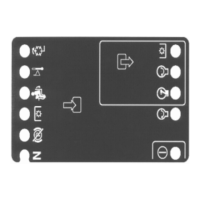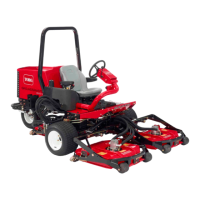• Do not put hands or feet near or under rotating
par ts . K ee p clear of the disc harg e opening at all
times .
• R emember there is no suc h thing as a safe slope .
T ra v el on g rass slopes requires par ticular care . T o
guard ag ainst o v er tur ning:
– do not stop or star t suddenly when g oing up
or do wnhill;
– mac hine speeds should be k e pt lo w on slopes
and during tight tur ns;
– sta y aler t for humps and hollo ws and other
hidden hazards;
– nev er mo w across the face of the slope , unless
the mo w er is designed for this pur pose .
– Use counterw eight(s) or wheel w eights when
sug g ested in the operator’ s man ual.
• Sta y aler t for holes in the ter rain and other hidden
hazards .
• W atc h out for traffic when crossing or near
roadw a ys .
• Stop the blades from rotating before crossing
surfaces other than g rass .
• W hen using any attac hments , nev er direct disc harg e
of material to w ard b ystanders nor allo w any one
near the mac hine while in operation.
• Nev er operate the mac hine with damag ed guards ,
shields , or without safety protecti v e devices in
place . Be sure all interloc ks are attac hed, adjusted
properly , and functioning properly .
• Do not c hang e the engine g o v er nor settings or
o v erspeed the engine . Operating the engine at
ex cessi v e speed ma y increase the hazard of personal
injur y .
• Before lea ving the operator’ s position:
– stop on lev el g round;
– diseng ag e the po w er tak e-off and lo w er the
attac hments;
– c hang e into neutral and set the parking brak e;
– stop the engine and remo v e the k ey .
Important: Allo w engine to idle f or 5
min utes bef or e shutting it of f after a full
load operation. F ailur e to do so may lead
to turbo-charger tr ouble.
• Diseng ag e dri v e to attac hments when transpor ting
or not in use .
• Stop the engine and diseng ag e dri v e to attac hment
– before refuelling;
– before remo ving the g rass catc her/catc hers;
– before making height adjustment unless
adjustment can be made from the operator’ s
position.
– before clearing bloc kag es;
– before c hec king, cleaning or w orking on the
mo w er;
– after striking a foreign object or if an abnor mal
vibration occurs . Inspect the mo w er for
damag e and mak e re pairs before restar ting and
operating the equipment.
• R educe the throttle setting during engine r un-out
and, if the engine is pro vided with a shut-off v alv e ,
tur n the fuel off at the conclusion of mo wing .
• K ee p hands and feet a w a y from the cutting units .
• Look behind and do wn before bac king up to be
sure of a clear path.
• Slo w do wn and use caution when making tur ns and
crossing roads and sidew alks . Stop blades from
rotating .
• Be a w are of the mo w er disc harg e direction and do
not point it at any one .
• Do not operate the mo w er under the influence of
alcohol or dr ugs
• Use care when loading or unloading the mac hine
into a trailer or tr uc k
• Use care when approac hing blind cor ners , shr ubs ,
trees , or other objects that ma y obscure vision.
Maintenance and Storage
• K ee p all n uts , bolts and screws tight to be sure the
equipment is in safe w orking condition.
• Nev er store the equipment with fuel in the tank
inside a building where fumes ma y reac h an open
flame or spark.
• Allo w the engine to cool before storing in any
enclosure .
• T o reduce the fire hazard, k ee p the engine ,
silencer/m uffler , batter y compar tment and fuel
storag e area free of g rass , lea v es , or ex cessi v e
g rease .
• Chec k the g rass catc her frequently for w ear or
deterioration.
• K ee p all par ts in g ood w orking condition and all
hardw are and h y draulic fittings tightened. R e place
all w or n or damag ed par ts and decals .
• If the fuel tank has to be drained, do this outdoors .
• Be careful during adjustment of the mac hine to
prev ent entrapment of the fing ers betw een mo ving
blades and fix ed par ts of the mac hine .
5

